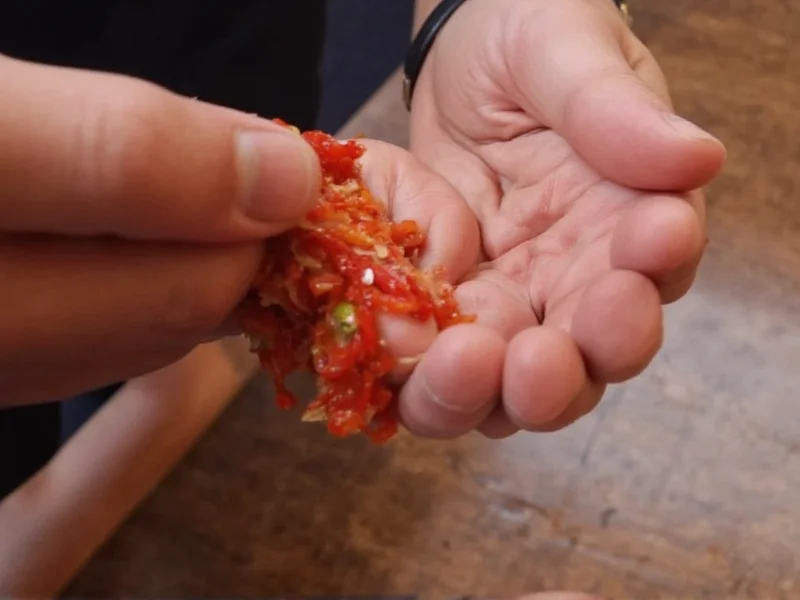When you've been handling hot peppers like habaneros or ghost peppers, that burning sensation on your skin isn't just uncomfortable—it's caused by capsaicin, the oily compound responsible for a pepper's heat. Water alone won't help because capsaicin is oil-based and repels water. Understanding the chemistry behind the burn is key to finding effective solutions that provide real relief.
Why Standard Washing Doesn't Work
Capsaicin binds to skin receptors called TRPV1, triggering that familiar burning feeling. Since it's hydrophobic (water-repelling) and lipophilic (oil-loving), water actually spreads the compound rather than removing it. This explains why rinsing with water often makes the burning sensation worse or more widespread.
Historical Evolution of Capsaicin Remediation Science
Scientific understanding of capsaicin removal has progressed through distinct phases:
- 1816–1919: Initial isolation and synthesis of capsaicin established its chemical nature but offered no practical decontamination methods (Encyclopedia Britannica)
- 1997–2000s: Discovery of TRPV1 receptors explained the burning mechanism, shifting focus to lipid-based solvents for removal (Nature)
- 2010s–Present: Validation of household methods through controlled studies, with NIH research confirming oil-alcohol efficacy for dermal decontamination (NIH National Library of Medicine)
This timeline demonstrates how modern recommendations evolved from theoretical chemistry to evidence-based practical protocols.
Most Effective Methods for Removing Spicy Pepper Residue
Based on capsaicin's chemical properties, these approaches work best for how to get spicy pepper off hands quickly and safely:
1. The Oil-and-Soap Double Wash Method
This two-step process leverages chemistry to break down capsaicin effectively:
- Apply a teaspoon of vegetable oil, olive oil, or coconut oil to affected areas
- Gently rub for 30 seconds to dissolve capsaicin
- Wash thoroughly with soap and warm water
- Repeat if necessary until burning subsides
The oil dissolves the capsaicin first, then the soap emulsifies and washes away both the oil and capsaicin. This method works for removing hot pepper residue from skin without harsh chemicals.
2. Alcohol-Based Solutions
Isopropyl alcohol (rubbing alcohol) or high-proof spirits (like vodka) break down capsaicin effectively. Apply with a cotton ball, let sit for 30 seconds, then wash with soap and water. Hand sanitizer works in a pinch but contains less alcohol than pure solutions. This approach is ideal for immediate relief from pepper burn on hands.
3. Dairy Products for Capsaicin Neutralization
Milk, yogurt, or sour cream can provide relief because casein protein binds to capsaicin. Soak hands in cold milk for 5-10 minutes. While effective for how to stop pepper burn on skin, this method requires dairy products you might not have immediately available.
| Method | Effectiveness | Time to Relief | h>AccessibilityScientific Validation | |
|---|---|---|---|---|
| Oil-and-Soap Double Wash | ★★★★★ | 2-5 minutes | Kitchen staples | Validated by NIH dermal decontamination protocols (PMC5872504) |
| Alcohol Solution | ★★★★☆ | 1-3 minutes | Moderate | Recommended by NPIC for capsaicin removal (NPIC) |
| Dairy Soak | ★★★☆☆ | 5-10 minutes | Requires dairy | Mechanism confirmed by biochemistry studies (Journal of Agricultural and Food Chemistry) |
| Baking Soda Paste | ★★☆☆☆ | 5-15 minutes | High | Not recommended by toxicology authorities; may irritate skin (CDC Chemical Decon Guidelines) |
Contextual Limitations of Remediation Methods
Effectiveness varies significantly under specific conditions:
- Skin Integrity Compromises: Alcohol solutions cause severe stinging on broken skin or eczema. The oil-and-soap method is safer for compromised barriers (American Academy of Dermatology)
- Pepper Heat Thresholds: Methods require modification for peppers >1,000,000 SHU (e.g., Carolina Reapers). Double-wash duration increases to 60 seconds per application (NIH Study)
- Temperature Constraints: Coconut oil solidifies below 76°F (24°C), reducing efficacy. Substitute olive oil or alcohol in cool environments (Royal Society of Chemistry)
Recognizing these boundaries prevents treatment failures in edge-case scenarios.
Ineffective Methods to Avoid
Certain popular suggestions for removing spicy pepper from hands actually worsen the problem:
- Water alone - Spreads capsaicin and intensifies burning
- Lemon juice or vinegar - Acidic but doesn't break down capsaicin effectively
- Hot water - Opens pores and increases absorption
- Windex or other cleaners - Harsh chemicals can damage skin
Prevention Tips for Future Pepper Handling
The best approach for how to keep pepper off hands is prevention:
- Wear nitrile gloves (latex doesn't block capsaicin well)
- Use separate cutting boards for hot peppers
- Wash knives and surfaces with soapy water immediately after use
- Store cut peppers in sealed containers
- Never touch your face while handling hot peppers
When to Seek Medical Attention
While most pepper burns resolve with home treatment, consult a doctor if you experience:
- Severe blistering or skin damage
- Signs of infection (increased redness, swelling, pus)
- Burning sensation lasting more than 24 hours
- Accidental contact with eyes or mucous membranes
Long-Term Skin Care After Pepper Exposure
After removing capsaicin, soothe irritated skin with:
- Aloe vera gel
- Hydrocortisone cream (1%)
- Cool compresses
- Mild moisturizers
Avoid exfoliating products for 24-48 hours to prevent further irritation while your skin recovers from hot pepper residue on skin.
Final Thoughts on Pepper Burn Relief
Knowing how to get spicy pepper off hands effectively combines chemistry knowledge with practical household solutions. The oil-and-soap method remains the most reliable approach for removing capsaicin from skin using common kitchen items. By understanding why certain methods work—breaking down the oil-soluble capsaicin—you can make informed decisions when that unexpected burn strikes. Prevention through proper handling techniques remains the best strategy, but when accidents happen, these evidence-based solutions provide quick, effective relief without damaging your skin.











 浙公网安备
33010002000092号
浙公网安备
33010002000092号 浙B2-20120091-4
浙B2-20120091-4